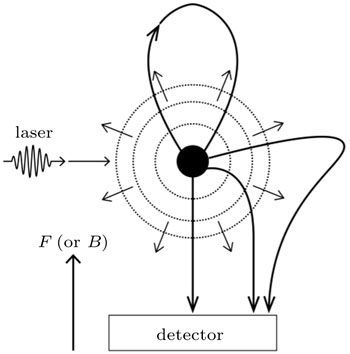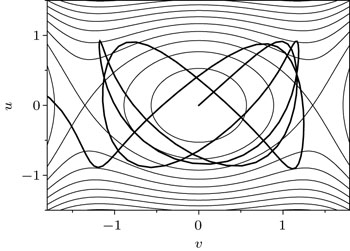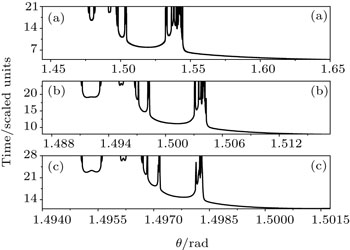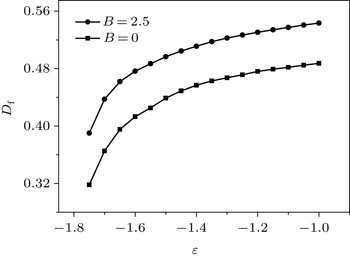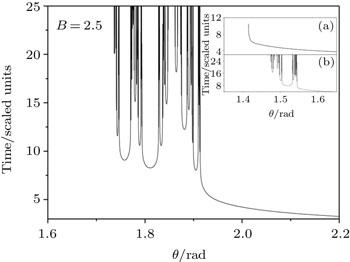† Corresponding author. E-mail:
Project supported by the Natural Science Foundation of Shandong Province, China (Grant No. ZR2014AM030).
We study the ionization of helium Rydberg atoms in an electric field above the classical ionization threshold within the semiclassical theory. By introducing a fractal approach to describe the chaotic dynamical behavior of the ionization, we identify the fractal self-similarity structure of the escape time versus the distribution of the initial launch angles of electrons, and find that the self-similarity region shifts toward larger initial launch angles with a decrease in the scaled energy. We connect the fractal structure of the escape time plot to the escape dynamics of ionized electrons. Of particular note is that the fractal dimensions are sensitively controlled by the scaled energy and magnetic field, and exhibit excellent agreement with the chaotic extent of the ionization systems for both helium and hydrogen Rydberg atoms. It is shown that, besides the electric and magnetic fields, core scattering is a primary factor in the fractal dynamics.
Over the past two decades, with the advancement of laser technology and semiclassical theory,[1–6] considerable attention has been paid to the ionization dynamics of Rydberg atoms and their photoionization or photodetachment in external fields.[7–13] The photoionization process in an electric field has been measured using a position-sensitive detector, which introduces the capability of visualizing an electric wave function on a macroscopic scale.[14–17] The chaotic ionization of hydrogen in parallel electric and magnetic fields is described by the Poincaré map.[18–21] The ionizing trajectories exhibit fractal self-similarity structures in the chaotic ionization of Rydberg atoms.[12] Recently, with the advancement of fractal physics, consideration has been given to fractal dynamics in quantum transport.[22] The escape dynamics of trapped ultracold atoms and Bose–Einstein condensates both exhibit fractal features.[23] Most investigations using a semiclassical description of Rydberg atoms in external fields have focused on hydrogen and alkali-metal atoms.[6,24–27] However, it is notable that, for helium Rydberg atoms with two atomic nuclei and other hydrogen-like atoms with only one electron in their outermost shell, the fractal dynamics in the presence of external fields remain unrealized. Hence, it is a challenge to find the correspondence between the fractal distribution in ionization systems and the escape dynamics of electrons in external fields.
In this paper, we use the semiclassical theory to investigate the self-similarity structure of helium Rydberg atoms in an electric field and introduce a fractal approach to describe the chaotic dynamical behavior. Moreover, the influences of the scaled energy and scaled magnetic field on the ionization mechanism are analyzed quantitatively. Comparing the fractal structures of helium atoms with those of hydrogen, we find that the escape time plots corresponding to different fractal dimensions show excellent agreement with the behavior of ionized electrons. Our research offers an efficient approach to describe the fractal dynamics in the ionization of Rydberg atoms. We hope that our results will provide a reliable theoretical basis for chaotic quantum transport and guide future photoionization microscopy experiments on helium or more complex atoms.
This paper is organized as follows. In Section 2, we briefly describe the ionization mechanism of helium Rydberg atoms and introduce the fractal method. The numerical results are discussed in Section 3, where we analyze the fractal structure of the escape time plot for helium atoms. Moreover, we calculate the corresponding fractal dimensions of both helium and hydrogen atoms under various external factors. The last section states the conclusions of our research.
A schematic view of the ionization system is given in Fig.
The Hamiltonian of highly excited electrons in helium atoms within an electric field can be written in cylindrical coordinates (ρ,z) as (in atomic units e = ħ = m = 1)

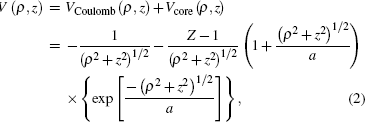
In the following, by introducing the scaling law r̃ = rF1/2, P̃ = PF−1/4, ɛ = EF−1/2, t̃ = tF3/4,[31] we obtain the transformed Hamiltonian







The above transformations remove the Coulomb singularity, and so every trajectory of the electron can launch from the origin and the Hamiltonian only depends on the scaled energy ɛ, rather than the energy E and the parameter F.
To investigate the chaotic escape quantitatively within the framework of the box-counting method[34] for the ionization of Rydberg atoms in external fields, the fractal dimension of the self-similarity structure that reflects the chaotic properties is defined as

A contour plot of the potential Vuv (ɛ = −1.3) is shown in Fig.
On account of the core scattering effect, multiple electrons can arrive at the detector plane and the escape behavior exhibits chaotic features. For the Hamiltonian in Eq. (
The escape time curves are shown in Fig.
Figure
We now extract the fractal dimension to describe the chaotic extent of the ionization of helium Rydberg atoms in a quantitative manner.
First, we plot a curve of the fractal dimension versus the scaled energy for B = 0 (see Fig.
The analytical method and fundamental theory above can be extended to ionization in parallel fields. By the analogous scaling laws[13,14] for helium Rydberg atoms in parallel electric and magnetic fields, the regularized Hamiltonian of the electron can be expressed as

Considering the core scattering effect in the chaotic escape of electrons for helium atoms, we compared the ionization of hydrogen Rydberg atoms in pure electric and parallel fields at the scaled energy ɛ = −1.3. When the hydrogen atom is placed in an electric field (B = 0), the Hamiltonian of the electron is integrable. The escape time plot, shown in inset (a) of Fig.
To further explore the influence of the magnetic field on the electrons, the relationship between the fractal dimension and scaled magnetic field is illustrated in Fig.
To investigate the influence of the scaled energy on the electrons, we calculated the fractal dimensions for different scaled energies under a fixed scaled magnetic field of B = 3.5. As shown in Fig.
We have studied the fractal dynamics of helium Rydberg atoms in an electric field within the framework of closed orbit theory. First, we found that a self-similarity structure exists in the escape time plot, and analyzed its chaotic properties qualitatively. The self-similarity region of the system was found to shift toward larger initial launch angles as the scaled energy decreases, which controls the fractal structure of the system. Moreover, core scattering induces the chaotic behavior of the ionization system. Second, we quantitatively analyzed the chaotic dynamical behavior of helium atoms, and obtained the fractal dimensions by analyzing the escape time plots. Finally, in a comparative analysis of hydrogen Rydberg atoms, we found that the fractal dimensions as a function of the scaled energy and scaled magnetic fields agree well with the chaotic escape dynamics in the ionization process. In addition, the influence of the magnetic field on the electrons is a primary factor in the chaotic extent of the hydrogen system. We believe that our work will provide a convenient tool for the fractal analysis of Rydberg atoms in external fields, and will be helpful to photoionization microscopy experiments for Rydberg atoms.
| 1 | |
| 2 | |
| 3 | |
| 4 | |
| 5 | |
| 6 | |
| 7 | |
| 8 | |
| 9 | |
| 10 | |
| 11 | |
| 12 | |
| 13 | |
| 14 | |
| 15 | |
| 16 | |
| 17 | |
| 18 | |
| 19 | |
| 20 | |
| 21 | |
| 22 | |
| 23 | |
| 24 | |
| 25 | |
| 26 | |
| 27 | |
| 28 | |
| 29 | |
| 30 | |
| 31 | |
| 32 | |
| 33 | |
| 34 |



